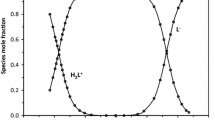Abstract
The interaction of adenosine 5′-monophosphate (AMP), adenosine 5′-diphosphate (ADP), and adenosine 5′-triphosphate (ATP) ions with protons in aqueous solution has been studied calorimetrically from 50 to 125°C and 1.52 MPa. At each temperature, the reaction of acidic AMP with tetramethylammonium hydroxide was combined with the heat of ionization for water to obtain the enthalpy of protonation of AMP, while the reactions of HCl with deprotonated tetramethylammonium salts of ADP and ATP were used to obtain the enthalpies of protonation of ADP and ATP. Equilibrium constant K, enthalpy change ΔHo, entropy change ΔSo, and heat capacity change ΔC op values were calculated for the stepwise protonation reactions as a function of temperature. The reactions involving the first protonation of AMP, ADP, and ATP and the third protonation of ADP and ATP were endothermic over the temperature range studied, while that involving the second protonation is exothermic for AMP and ADP, but is exothermic below 100°C and endothermic at 125°C in the case of ATP. Consequently, log K values for the first and third protonation reactions (phosphate groups) increase while those for the second protonation reaction (N1-adenine) decrease in the cases of AMP and ADP and go through a minimum in the case of ATP as temperature increases. The ΔHo values for all protonation reactions increase with temperature. The magnitude and the trend for the ΔHo, ΔSo, and ΔC op values with temperature are discussed in terms of solvent-solute interactions. The magnitude of the ΔC op values for the second protonation is consistent with little interaction between the phosphate ion and the protonated N1 site of the adenine moiety in AMP, but indicates moderate interaction between these groups in ADP, and strong interaction in ATP.
Similar content being viewed by others
References
G. L. Eichhorn and L. G. Marzilli,Metal Ions in Genetic Information Transfer, (Vol. 3 of Advances in Inorganic Biochemistry, Elsevier, New York, 1981).
V. Tunnicliffe,Am. Sci. 80:336 (1992).
Origins of Life and Evolution of the Biosphere,22:1 (1992). Special Issue: Marine Hydrothermal Systems and the Origin of Life, N.G. Holm, ed, 241 pp.
R. Phillips,Chem. Rev. 66:501 (1966).
R. M. Izatt, J. J. Christensen, and J. H. Rytting,Chem. Rev. 71:439 (1971).
R. M. Smith, A. E. Martell and Y. Chen,Pure Appl. Chem. 63:1015 (1991).
M. M. Taqui Khan, and A. E. Martell,J. Am. Chem. Soc. 89:5585 (1967).
J. Galea, R. Beccaria, and G. Ferroni,Electrochim. Acta. 23:647 (1978).
J. J. Christensen, L. D. Hansen, and R. M. Izatt,Handbook of Proton Ionization Heats and Related Thermodynamic Quantities (John Wiley & Sons, New York, 1976).
H. Sigel,Eur. J. Biochem. 163:353 (1987).
M. L. Antonelli, S. Balzamo, V. Carunchio, E. Cernia, and R. Purrello,J. Inorg. Biochem. 32:153 (1988).
M. E. Tate,Biochem. J. 195:419 (1981).
S. S. Massoud, R. Tribolet, and H. Sigel,Eur. J. Biochem. 187:387 (1990).
S. M. Shanbhag and G. R. Choppin,Inorg. Chim. Acta 138:187 (1987).
M. V. Rekharshii, S. A. Tishchenko, A. M. Egorov, and G. L. Galchenko,Vestn. Mosk. Univ., Ser. 2: Khim. 29:46 (1988).
R. N. Goldberg and Y. B. Tewari,Biophys. Chem. 40:241 (1991).
R. A. Alberty,J. Am. Chem. Soc. 91:3899 (1969).
G. A. Walker, S. C. Bhatia, and J. H. Hall, Jr.,J. Am. Chem. Soc. 109:7629 (1987).
Y. Kitaoka,J. Chromatography 168:241 (1979).
S. Neidle, W. Kuhlbrandt, and A. Achari,Acta Crystallogr. B32:1850 (1976).
M. Matthies and G. Zundel,J. Chem. Soc. Perkin II:1824 (1977).
H. A. Tajmir-Riahi, M. J. Bertrand, and T. Theophanides,Can. J. Chem. 64:960 (1986).
H. A. Tajmir-Riahi,Biochimica et Biophys. Acta 1087:49 (1990).
J. J. Christensen and R. M. Izatt,J. Phys. Chem. 66:1030 (1962).
M. Cohn and T. R. Hughes, Jr.,J. Biol. Chem. 235:3250 (1960).
S. Biagnini, M. Casu, A. Lai, R. Caminiti, and G. Crisponi,J. Chem. Phys. 93:461 (1985).
S. E. Gillespie, J. L. Oscarson, R. M. Izatt, and P. Wang,Thermochim. Acta. (in press).
R. M. Izatt, J. L. Oscarson, S. E. Gillespie, and X. Chen,Determination of Thermodynamic Data for Modeling Corrosion. Volume 4: Chloride Ion Interaction with Magnesium, Calcium, and Hydrogen Ions at 250–325°C EPRI Report NP-5708, (Electric Power Research Institute, Palo Alto, CA, 1992).
A. R. Parkinson, R. J. Balling, and J. C. Free,Proc. ASME Int. Computers in Eng. Conf. (Las Vegas, NV, Aug. 1984).
H. Sigel,CHIMIA 41:11 (1987).
R. Tribolet and H. Sigel,Biophys. Chem. 27:119 (1987).
K.H. Scheller, F. Hofstetter, P. R. Mitchell, B. Prijs, and H. Sigel,J. Am. Chem. Soc. 103:247 (1981).
L.G. Hepler,J. Phys. Chem. 61:1426 (1957).
R. M. Izatt, S. E. Gillespie, J. L. Oscarson, P. Wang, J. A. R. Renuncio, and C. Pando,J. Solution Chem. 23:449 (1994).
W. L. Marshall and E. U. Franck,J. Phys. Chem. Ref. Data 10:295 (1981).
R. M. Izatt, J. L. Oscarson, S. E. Gillespie, X. Chen, P. Wang, and G.D. Watt,Pure Appl. Chem. (in press).
J. L. Oscarson, S. E. Gillespie, J. J. Christensen, R. M. Izatt, and P. R. Brown,J. Solution Chem. 17:865 (1988).
J. L. Oscarson, R. M. Izatt, P. R. Brown, Z. Pawlak, S.E. Gillespie, and J. J. Christensen,J. Solution Chem. 17:841 (1988).
G.H. Haggis, J.B. Hasted, and T.J. Buchanan,J. Chem. Phys. 20:1452 (1952).
W. T. Lindsay, Jr.,The ASME Handbook on Water Technology for Thermal Power Systems, P. Cohen, ed. (The American Society of Mechanical Engineers, New York, 1989) Chap. 7.
J. W. Cobble and S. W. Lin,The ASME Handbook on Water Technology for Thermal Power Systems, P. Cohen, ed. (The American Society of Mechanical Engineers, New York, 1989), Chap. 8.
R.M. Izatt, J.L. Oscarson, S.E. Gillespie, H. Grimsrud, J.A.R. Renuncio, and C. Pando,Biophys. J. 61:1394 (1992).
S. E. Gillespie, J. L. Oscarson, R. M. Izatt. P. Wang, J. A. R. Renuncio, and C. Pando,J. Solution Chem. (submitted).
T. Glonek,Int. J. Biochem. 24:1533 (1992).
A.P. Sarvazyan, V.A. Buckin, and P. Hemmes,J. Phys. Chem. 84:692 (1980).
Author information
Authors and Affiliations
Rights and permissions
About this article
Cite this article
Oscarson, J.L., Wang, P., Gillespie, S.E. et al. Thermodynamics of protonation of AMP, ADP, and ATP from 50 to 125°C. J Solution Chem 24, 171–200 (1995). https://doi.org/10.1007/BF00972840
Issue Date:
DOI: https://doi.org/10.1007/BF00972840




